Veerabhadra Swamy Temple Lepakshi: 26Ft Huge Nandi, Hanging Pillar
The Veerabhadra Swamy Temple in Lepakshi, Andhra Pradesh, India, is a significant and historically important temple dedicated to Lord Veerabhadra, a fierce form of Lord Shiva. This temple is renowned for its magnificent architecture, intricate sculptures, and rich cultural and historical significance.
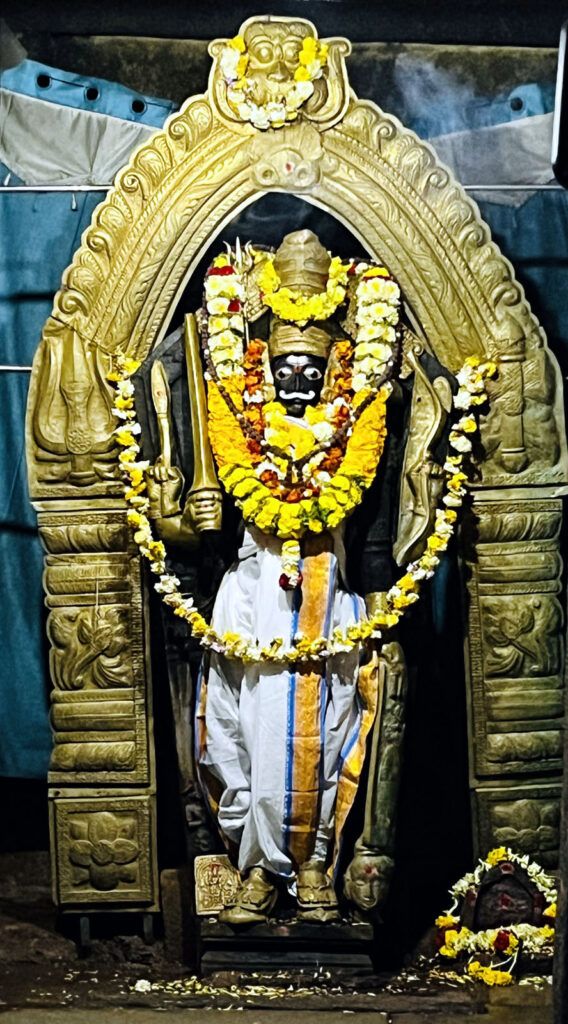
Contents
- 1 History of Veerabhadra Swamy Temple in Lepakshi:
- 2 Significance of Veerabhadra Swamy Temple in Lepakshi:
- 3 Legend of Veerabhadra Swamy Temple in Lepakshi:
- 4 Myth of Veerabhadra Swamy Temple in Lepakshi:
- 5 The architecture of Veerabhadra Swamy Temple in Lepakshi:
- 6 Veerabhadra Swamy Temple Timing:
- 7 Nandi at Veerabhadra Swamy Temple in Lepakshi:
- 8 Hanging Pillar at Veerabhadra Swamy Temple in Lepakshi:
- 9 Places to visit near Veerabhadra Swamy Temple in Lepakshi:
- 10 FAQ:
- 11 How to reach Veerabhadra Swamy Temple in Lepakshi:
- 12 Google Maps:
History of Veerabhadra Swamy Temple in Lepakshi:
The Veerabhadra Swamy Temple in Lepakshi, Andhra Pradesh, India, is a Hindu temple dedicated to Veerabhadra, a fierce incarnation of Lord Shiva. It was built in the 16th century by Virupanna Nayaka and Viranna, two brothers who were Governors under the Vijayanagara Empire during the reign of King Achutaraya. The temple is a fine example of Vijayanagara architecture, with a profusion of carvings and paintings at almost every exposed surface.
The temple is also known for its hanging pillar, a marvel of engineering that defies gravity. The pillar is one of 70 pillars that support the ceiling of the main shrine, but it does not touch the ground. There is a small gap between the pillar and the floor, through which a piece of paper can be passed. The exact method of construction of the hanging pillar is unknown, and it remains a mystery to this day.
According to legend, the name Lepakshi comes from the Telugu words lepa (embalmed eye) and akshi (eye). It is said that the bird Jatayu, who was mortally wounded by Ravana while trying to protect Sita, fell to the ground at the spot where the temple now stands. Rama, upon finding Jatayu, is said to have exclaimed, “Le Pakshi!” (Arise, bird!) Hence the name Lepakshi.
Read More>> 2500 Years Dwarkadhish Temple: Where Miracles Still Happen
Significance of Veerabhadra Swamy Temple in Lepakshi:
Religious Significance
The temple is dedicated to Veerabhadra, a fierce incarnation of Lord Shiva. Veerabhadra is worshipped as a powerful deity who can protect his devotees from all harm. The temple is a popular pilgrimage site for Hindus from all over India.
Architectural Significance
The Veerabhadra Swamy Temple is a fine example of Vijayanagara architecture. The temple was built in the 16th century during the peak of the Vijayanagara Empire. The temple is known for its intricate carvings, sculptures, and paintings. The temple complex is also notable for its large monolithic Nandi statue, which is one of the largest in India.
Cultural Significance
The Veerabhadra Swamy Temple is not only a religious and architectural marvel, but it is also a significant cultural landmark. The temple complex is home to a number of murals and sculptures that depict scenes from Hindu mythology and epics. These murals and sculptures provide valuable insights into the cultural and religious beliefs of the Vijayanagara period.
UNESCO World Heritage Tentative List
The Veerabhadra Swamy Temple has been inscribed on the UNESCO World Heritage Tentative List. This means that the temple has been recognized by UNESCO as a potential World Heritage Site. If the temple is inscribed on the World Heritage List, it will receive international recognition and protection.
Read More>> Enchanted Pashupatinath Temple: 5th Century Sacred Hindu Temple
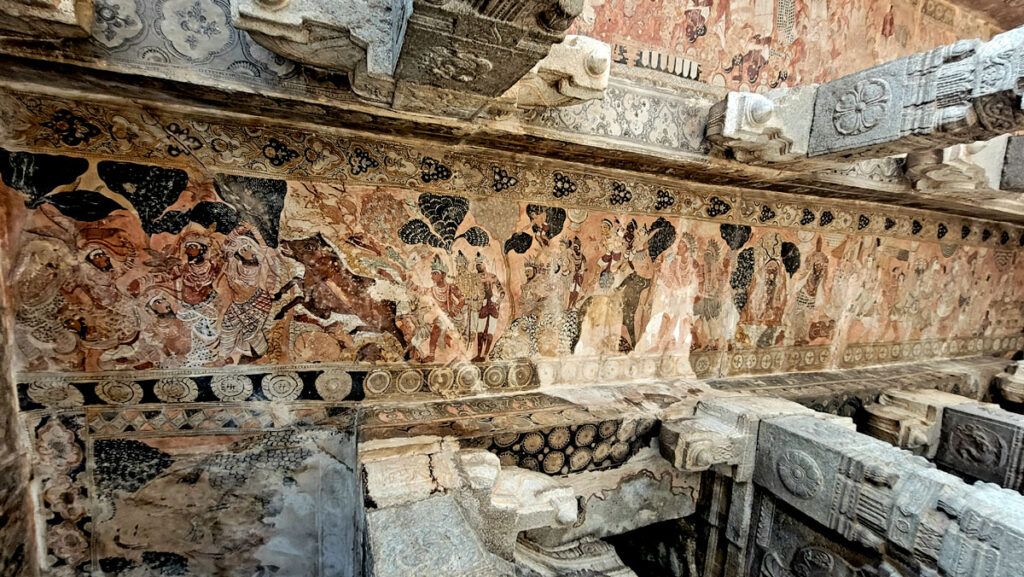
Legend of Veerabhadra Swamy Temple in Lepakshi:
The legend of the Veerabhadra Swamy Temple begins with the story of Daksha Yajna, a sacrifice performed by Daksha Prajapati, the father of Sati, the wife of Lord Shiva. Daksha had invited all the gods and goddesses to the sacrifice, but he deliberately excluded his daughter Sati and her husband, Lord Shiva.
Sati was deeply hurt by her father’s rejection, and she committed suicide by jumping into the sacrificial fire. Lord Shiva was enraged by his wife’s death, and he manifested a fierce form known as Veerabhadra. Veerabhadra killed Daksha and scattered his ashes to the four corners of the world.
After killing Daksha, Veerabhadra went on a rampage, destroying everything in his path. The gods were terrified of Veerabhadra’s rage, and they begged Lord Vishnu to intervene. Lord Vishnu appeared before Veerabhadra and explained that Daksha had been punished for his arrogance. Veerabhadra was eventually calmed down, and he returned to his normal form.
The Veerabhadra Swamy Temple is said to have been built by Veerabhadra himself, as a place of penance for his actions. The temple is located in the village of Lepakshi, which is said to be the site of Sati’s suicide.
Sati was the daughter of Daksha Prajapati, the father of all the gods and goddesses. She was married to Lord Shiva, the god of destruction. Daksha was a devout follower of Lord Vishnu, and he did not approve of his daughter’s marriage to Shiva.
Read More>> Arunachalam Giri Pradakshina: Sacred 8 Lingams of Tiruvannamalai
Daksha organized a grand sacrifice, and he invited all the gods and goddesses, except for Shiva and Sati. Sati was deeply hurt by her father’s rejection, and she decided to attend the sacrifice anyway.
When Sati arrived at the sacrifice, she was greeted by her father with cold indifference. Daksha insulted Shiva, and he even refused to give Sati a seat of honor.
Sati was humiliated and heartbroken. She could not bear the thought of her husband being insulted by her father. She jumped into the sacrificial fire and died.
- Veerabhadra’s birth
Shiva was enraged by his wife’s death. He manifested a fierce form known as Veerabhadra, and he set out to destroy Daksha.
Veerabhadra killed Daksha and scattered his ashes to the four corners of the world. He also destroyed the sacrificial grounds, and he killed many of the gods and goddesses who had attended the sacrifice.
- Veerabhadra’s penance
After his rampage, Veerabhadra was filled with remorse. He realized that he had gone too far, and he sought penance for his actions.
Veerabhadra came to the village of Lepakshi, which is said to be the site of Sati’s suicide. He built a temple there, and he dedicated it to his wife.
The temple is known as the Veerabhadra Swamy Temple. It is a place where Veerabhadra could atone for his sins and find peace.
Read More>> Pancharama Kshetras: Kartikeya Breaks the Shivalinga into 5
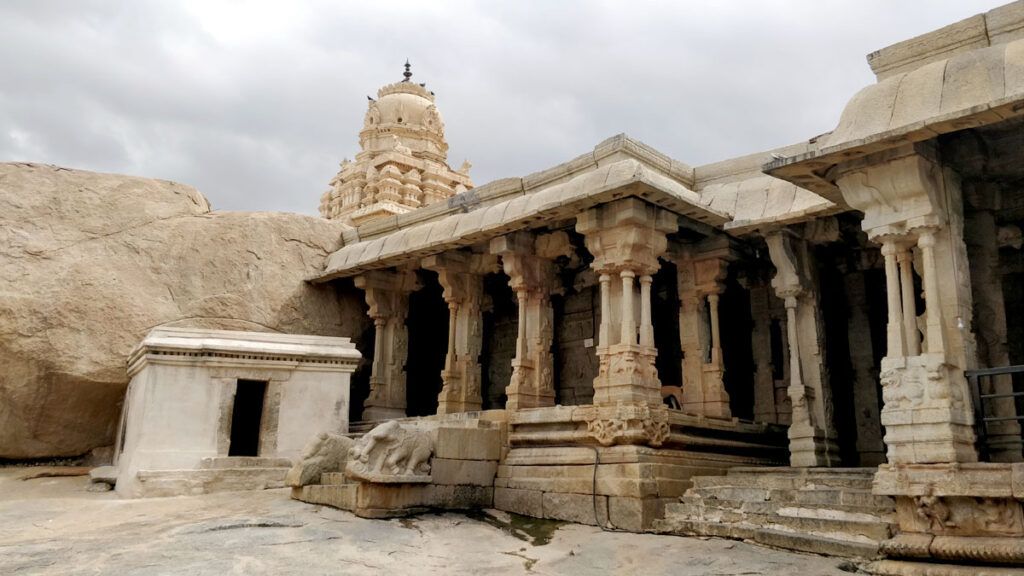
Myth of Veerabhadra Swamy Temple in Lepakshi:
The Veerabhadra Swamy Temple in Lepakshi, India, is shrouded in myths and legends. The temple is dedicated to Veerabhadra, the fierce incarnation of Lord Shiva. Here are some of the myths associated with the temple:
1. The Hanging Pillar
One of the most famous mysteries of the Lepakshi temple is the hanging pillar. This pillar is suspended about an inch above the ground, and it is said that you can pass a paper or even a cloth underneath it. There are many theories about how the pillar was constructed, but the most popular one is that it was done using some kind of ancient technology that has been lost to time.
2. The Footprints of Sita
Another popular legend is that the footprints of Sita, the wife of Lord Rama, can be found in the temple premises. It is said that when Sita was being abducted by Ravana, the bird Jatayu fought with Ravana to rescue her. Jatayu was mortally wounded in the battle, and he fell to the ground in Lepakshi. When Rama and Lakshmana arrived in Lepakshi, they saw the footprints of Sita and knew that she had been kidnapped by Ravana.
3. The Punishment of the Accountant
There is also a legend about the accountant who was responsible for the construction of the temple. It is said that the accountant embezzled money from the temple funds, and when the king found out, he was furious. The king ordered the accountant’s eyes to be gouged out, and it is said that the bloodstains from the punishment can still be seen on one of the walls of the temple.
4. The Disappearing Nandi
The Nandi statue in front of the Lepakshi temple is said to have miraculous powers. It is said that if you pray to the Nandi statue with a sincere heart, your wishes will be fulfilled. However, there is also a legend that the Nandi statue disappears from time to time. It is said that the Nandi statue disappears to go and protect its devotees from harm.
Read More>> Brihadeeswarar Temple: Timeless Marvel of Chola Architecture
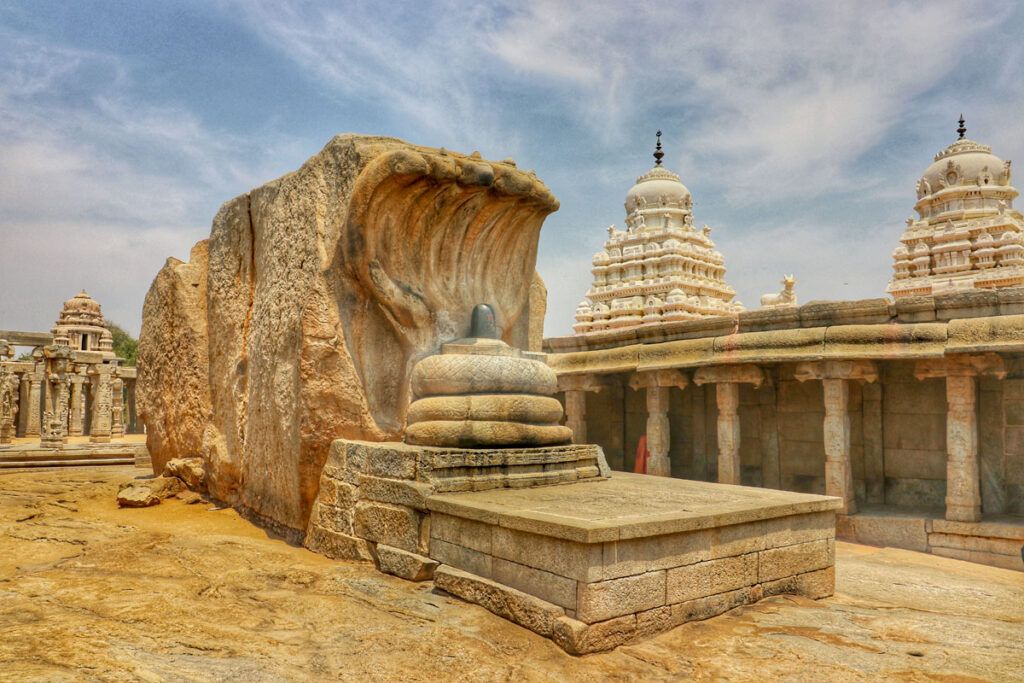
The architecture of Veerabhadra Swamy Temple in Lepakshi:
Mandapa: The temple complex consists of three main parts: the Mukha Mandapa (front hall), the Artha Mandapa (vestibule), and the Garbhagriha (sanctum sanctorum). The Mukha Mandapa is known for its large and intricately carved pillars.
Pillars: The most remarkable feature of the temple is its numerous monolithic stone pillars. These pillars are famous for their exquisite carvings, including depictions of divine beings, dancers, musicians, and various mythological scenes. The Hanging Pillar, a pillar that appears to be unsupported, is one of the most famous and intriguing aspects of the temple’s architecture.
Ceiling Paintings: The ceilings of the temple are adorned with beautiful paintings, showcasing scenes from the epics Ramayana and Mahabharata, as well as various gods and goddesses. The frescoes are vibrant and have retained their colors remarkably well over the centuries.
Sculptures: The temple is adorned with a multitude of sculptures, including depictions of various deities, mythical creatures, and intricate relief work. The most famous sculpture is the massive, monolithic Nandi (the bull mount of Lord Shiva), which stands at the entrance.
Kalyana Mandapa: The temple complex also features a Kalyana Mandapa, a wedding hall where the divine marriage of Lord Shiva and Goddess Parvati is celebrated annually with a grand ceremony.
Nandi Shrine: Adjacent to the main temple is a shrine dedicated to Lord Shiva’s vahana (mount), Nandi. This shrine is also adorned with beautiful carvings and sculptures.
Frescoes and Inscriptions: The walls of the temple are covered with frescoes, some of which depict scenes from the lives of saints and sages. There are also several inscriptions in Telugu and Kannada that provide historical information about the temple and its construction.
Dravidian and Hoysala Influences: The temple’s architecture is a fusion of Dravidian and Hoysala architectural styles, with elements such as the stepped pyramidal tower (shikhara) and intricately carved temple walls resembling Hoysala style, while the layout and plan are more characteristic of Dravidian temples.
Read More>> Konark Sun Temple 13th Century Gem
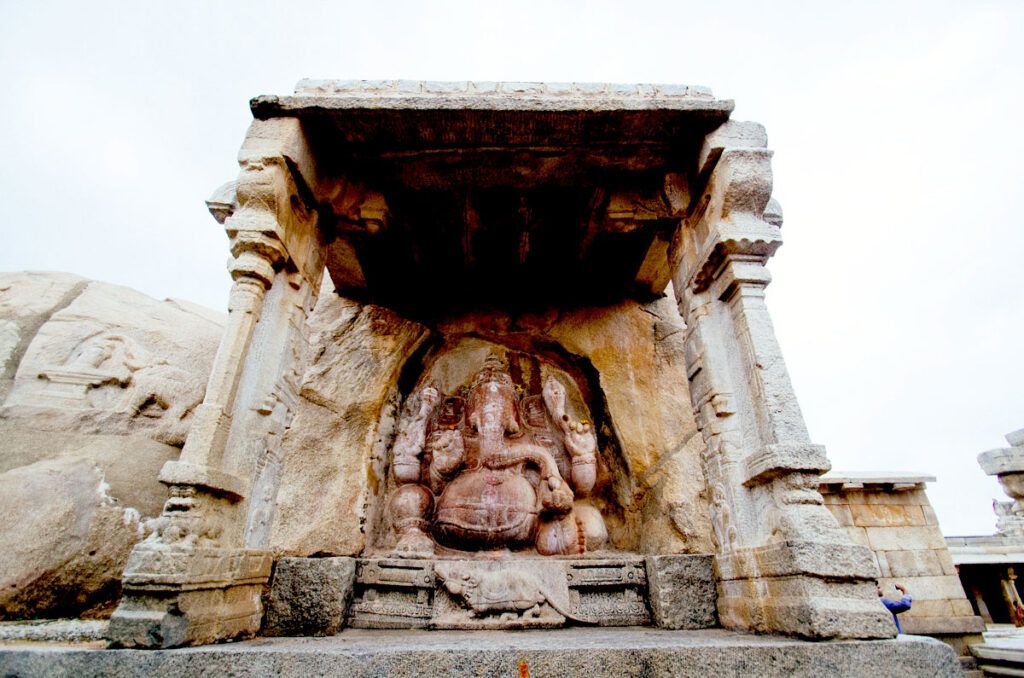
Veerabhadra Swamy Temple Timing:
- Temple Opening Hours: The temple is usually open to the public from early morning to late evening.
- Darshan Timings: Devotees can visit the temple for darshan during the following hours:
- Morning: 6:00 AM to 1:00 PM
- Evening: 2:00 PM to 6:00 PM
Nandi at Veerabhadra Swamy Temple in Lepakshi:

Lepakshi Nandi is a monolithic statue of Nandi, the bull-vahana of Lord Shiva, carved out of a single piece of granite. It is located in the Lepakshi village in Anantapur district of Andhra Pradesh, India. The statue is one of the largest and most impressive Nandi statues in India, and is considered to be a masterpiece of Vijayanagara art.
The Nandi is 27 feet long and 15 feet high, and is carved in a seated pose with its head lowered. The statue is decorated with intricate carvings of flowers, vines, and other motifs. The Nandi’s horns are particularly impressive, and are said to represent the sun and the moon.
The Nandi is located in a small park near the Veerabhadra Swamy Temple in Lepakshi. The temple is dedicated to Veerabhadra, the wrathful incarnation of Lord Shiva. The Nandi is a popular tourist destination, and is often visited by pilgrims from all over India.
The Nandi is believed to be sacred, and is said to have the power to grant wishes. Devotees often come to the Nandi to pray for good fortune and blessings. The Nandi is also a popular subject for photography, and is often featured in postcards and other souvenirs of Lepakshi.
Read More>> Char Dham Yatra – A Complete Guide to Spiritual Destination
Hanging Pillar at Veerabhadra Swamy Temple in Lepakshi:

“The Hanging Pillar of the Veerabhadra Swamy Temple in Lepakshi, Andhra Pradesh, India, is one of the most mysterious and intriguing architectural features in the world. The pillar, which is located in the main hall of the temple, is about 13 feet tall and weighs about 30 tons. It is supported by a single, delicate stone bracket that is only about 4 inches thick.
The pillar has been the subject of much speculation and debate over the centuries. Some believe that it was built by using a complex system of pulleys and counterweights, while others believe that it is simply a natural phenomenon. There is no scientific consensus on how the pillar was constructed, and it remains one of the temple’s most enduring mysteries.
The temple itself is a beautiful example of Vijayanagara architecture. It was built in the 16th century by the brothers Virupanna and Viranna, who were governors of the region under the Vijayanagara Empire. The temple is dedicated to the Hindu god Veerabhadra, who is an incarnation of Shiva.
Read More>> Dhandayuthapani Swamy Temple, Palani
Places to visit near Veerabhadra Swamy Temple in Lepakshi:
Lepakshi Nandi: Located close to the Veerabhadra Swamy Temple, the colossal monolithic Nandi (bull) statue is a must-see. It’s one of the largest Nandi sculptures in India and is carved from a single block of granite.
Virupaksha Temple, Hampi: Hampi, a UNESCO World Heritage Site, is not too far from Lepakshi. The Virupaksha Temple is one of the most important temples in Hampi, known for its historical and architectural significance.
Tadipatri: Tadipatri is another town in Andhra Pradesh, famous for its ancient temples and architectural heritage. The Bugga Ramalingeswara Temple and the Chintala Venkataramana Swamy Temple are worth visiting.
Hindupur: This nearby town has a few attractions such as the Isvara Temple and the Sri Raghavendra Swamy Mutt, a religious and spiritual center.
Horsley Hills: About 120 kilometers from Lepakshi, Horsley Hills is a charming hill station known for its natural beauty, pleasant climate, and viewpoints.
Gandikota: Also known as the “Grand Canyon of India,” Gandikota is a picturesque gorge formed by the Pennar River. It offers stunning views and is home to the Gandikota Fort, a historic site.
Belum Caves: Located about 80 kilometers from Lepakshi, the Belum Caves are the second-largest natural caves in the Indian subcontinent. They are known for their unique stalactite and stalagmite formations.
Anantapur: The city of Anantapur is known for its historical and cultural heritage. Some of the attractions include the Sri Kadiri Lakshmi Narasimha Swamy Temple and the ISKCON Temple.
Nandi Hills: While not very close, Nandi Hills is a popular hill station and weekend getaway from Bangalore. It’s known for its scenic beauty and the Nandi Temple at the hilltop.
Puttaparthi: If you’re interested in spiritual and religious experiences, you can visit Puttaparthi, the birthplace of Sri Sathya Sai Baba. The Prasanthi Nilayam Ashram is a significant place of interest.
FAQ:
What is the Veerabhadra Swamy Temple?
The Veerabhadra Swamy Temple is a Hindu temple located in the village of Lepakshi in the Anantapur district of Andhra Pradesh, India. The temple is dedicated to Veerabhadra, a fierce incarnation of Lord Shiva. It was built in the 16th century during the Vijayanagara Empire.
What are the architectural features of the temple?
The temple is built in the Vijayanagara style of architecture. It is a large complex with a number of shrines, pillars, and sculptures. The temple is known for its intricate carvings and paintings, which depict scenes from Hindu mythology.
What are some of the notable features of the temple?
- The temple has a hanging pillar, which is a unique architectural feature. The pillar is supported by a single block of stone, but it does not touch the ground.
- The temple has a number of sculptures of Hindu deities, including Shiva, Vishnu, and Lakshmi.
- The temple has a number of murals, which depict scenes from Hindu mythology.
How to reach the temple?
The temple is located about 140 kilometers from Bangalore. The nearest airport is the Kempegowda International Airport in Bangalore. The nearest railway station is the Hindupur railway station. The temple is accessible by road from both Bangalore and Hindupur.
What are the visiting hours of the temple?
The temple is open from 6am to 8pm daily.
What are the entry fees for the temple?
There is no entry fee for the temple. However, there is a camera fee of INR 50.
What are some tips for visiting the temple?
- Wear comfortable shoes as you will be doing a lot of walking.
- Bring a hat and sunscreen to protect yourself from the sun.
- Respect the religious beliefs of others.
How to reach Veerabhadra Swamy Temple in Lepakshi:
By Air:
The nearest major airport is Kempegowda International Airport in Bangalore, Karnataka, which is approximately a 2 to 2.5-hour drive from Lepakshi.
By Train:
The nearest railway station to Lepakshi is Hindupur Railway Station. From Hindupur, you can hire a taxi or take a bus to reach Lepakshi, which is about a 30-minute drive away.
By Road:
Lepakshi is well connected by road. You can reach it by taking a bus or driving if you have your own vehicle. It’s accessible from various nearby towns and cities in Karnataka and Andhra Pradesh.
Public Transportation:
You can take a bus from Hindupur or other nearby towns to reach Lepakshi. There are also local transportation options available.
Local Transportation:
Once you reach Lepakshi, you can hire a local auto-rickshaw or taxi to take you to the Veerabhadra Swamy Temple. The temple is a short distance from the town center.
